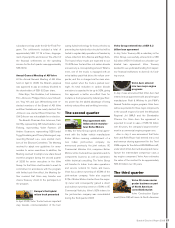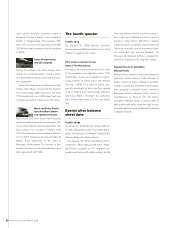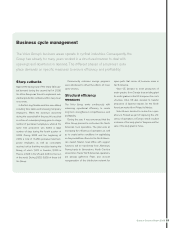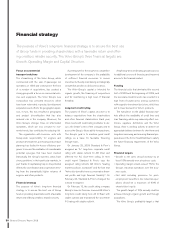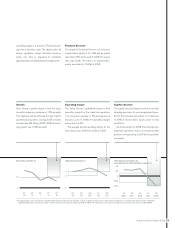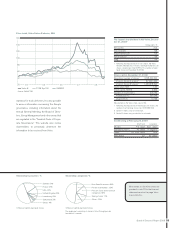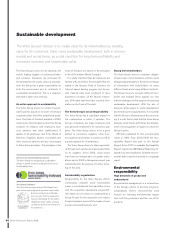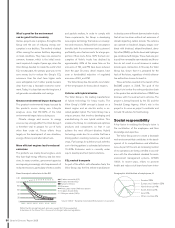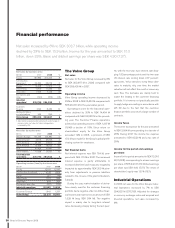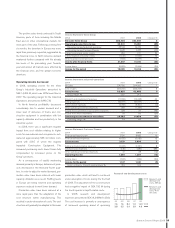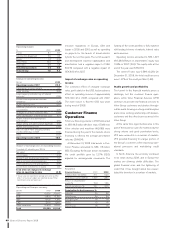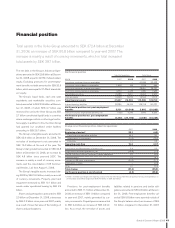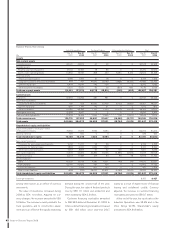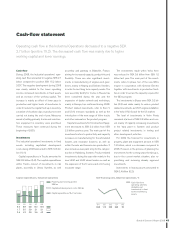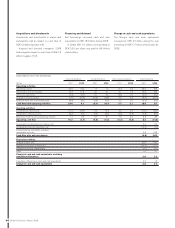Volvo 2008 Annual Report Download - page 41
Download and view the complete annual report
Please find page 41 of the 2008 Volvo annual report below. You can navigate through the pages in the report by either clicking on the pages listed below, or by using the keyword search tool below to find specific information within the annual report.
Key figures 2007 2008
Number of employees at year-end 101,700 101,380
Share of women, % 17 17
Share of women, Board Members, % 11 10
Share of women, Presidents and other senior executives, % 15 17
Absence due to illness of regular working hours, %
Total absence due to illness of regular working hours, % 5.1 4.6
of which continous sick leave for 60 days or more, % 46.2 39.1
Absence due to illness (as percentage of regular working hours) by gender
Men, % 4.8 4.4
Women, % 6.3 5.4
Absence due to illness (as percentage of regular working hours) by age
29 years or younger, % 4.6 4.6
30–49 years, % 5.1 4.6
50 years and older, % 5.5 4.8
sified. These efforts encompass work-place
ergonomics, health risks, support programs
and medical examinations.
The Volvo Group Attitude Survey is an
annual Groupwide survey. In the survey,
employees express their views on their work
and areas that need improvement. The results
of the survey are discussed in each team and
used to identity key improvement areas. The
proportion of satisfied employees has steadily
improved in recent years. In 2008, the propor-
tion of satisfied employees was 86%, com-
pared with 84% in the preceding year.
The Volvo Group as employer
The Group strives to be an attractive employer,
both for current and future employees. At the
end of 2008, a total of 101,380 people were
employed by the Group. Every employee is
expected to take an active role in the Group’s
development, process of change and future.
The Group is working in a number of different
areas, such as fitness programs, skill develop-
ment, work environment and leadership sup-
port in an effort to be an attractive employer.
Cutbacks in production
The past years have been characterized by
strong demand and record sales, which has
resulted in the Group having significant recruit-
ment need. Against the background of the rapid
slowdown of the world economy and cor-
responding sharply reduced demand, measures
are being taken to lower cost levels within the
Group. These measures include a reduction in
personnel and a review of all expenses. As a
result of the weak demand, a total of 16,255
permanent employees, temporary employees
and consultants received layoff notices during
2008 and the beginning fo 2009. Before going
so far as redundancy notices, a host of other
measures were taken, including the utilization
of flexible time banks. The Volvo Group is fol-
lowing national regulations in conjunction with
terminations of employment and is cooperating
closely with the unions.
Increased diversity – a strategic goal
One of the Volvo Group’s strategic goals is to
raise awareness about and capitalize on the
diversity that exists throughout the organiza-
tion. For an international group it is essential
that the organization reflects its customers
and understands the conditions prevailing in
local markets, different cultures and future
employees’ requirements. Diversity generates
creativity, which in turn leads to innovation: a
prerequisite for success.
Product quality and safety
Safety issues are a natural component of the
development of world-leading commercial
transport solutions. The Group strives to min-
imize the risk and consequences of accidents
and improve driver safety and work environ-
ment. Human errors or misjudgments are a
decisive or strongly contributory factor in most
accidents, a fact that reflects the importance
of good visibility, driving characteristics and
brakes.
The Group is also a leader in designing ve-
hicles that protect the driver and passengers in
the event of a collision. Safety solutions include
rollover-tested cabs and bodies, frontal colli-
sion protection, deformation zones, seat belts,
deformable fittings and airbags.
The Group is also a leader in improving safety
for other road-users. As early as 1996, the
company introduced the Front Underrun Pro-
tection System to prevent passenger cars from
becoming wedged beneath trucks in a frontal
collision. This protection system has been fitted
as standard to Volvos trucks in the EU since
2001, and in 2003 the protection system
became a legal requirement in EU countries.
Volvo Group Sustainability Report
report will be available on
www.volvogroup.com in mid-April.
Volvo Groups environmental per-
formance For information on the Volvo
Groups environmental performance see
the Eleven-year summary on page 151.
37
Board of Directors’ Report 2008


